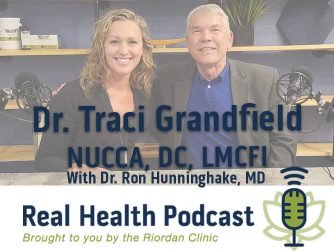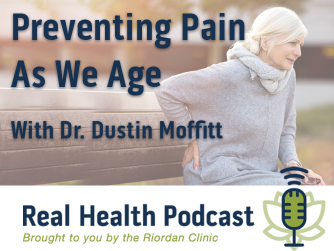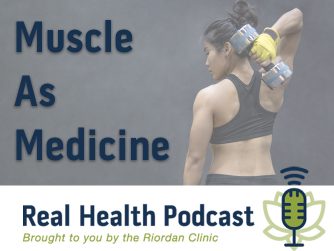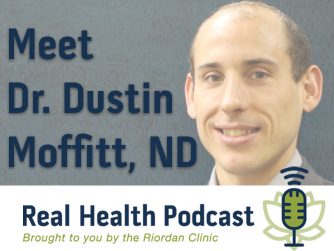Dr. Ron Hunninghake, MD, Chief Medical Officer welcomes colleague Dr. Dustin Moffitt, ND, who discusses how regenerative therapies assist him when working with patients with arthritis and other chronic inflammatory conditions. Dr. Moffitt uses treatments like Prolotherapy, Prolozone, and Platelet Rich Plasma (PRP) to help stimulate the wound to reboot the healing process.
Thank You To This Episode’s Sponsor
Episode Links and Promotions
May 2022 Health Hunters Article – Arthritis, Injuries, and Pain
Episode Transcript
Disclaimer: The information contained on the Real Health Podcast and the resources mentioned are for educational purposes only. They are not intended as, and shall not be understood or construed as medical or health advice. The information contained on this podcast is not a substitute for medical or health advice from a professional who is aware of the facts and circumstances of your individual situation. Information provided by hosts and guests on the Real Health Podcast or the use of any products or services mentioned does not create a practitioner patient relationship between you and any person’s affiliated with this podcast.
Intro: This is the Real Health Podcast brought to you by Riordan Clinic. Our mission is to bring you the latest information and top experts in functional and integrative medicine to help you make informed decisions on your path to real health.
Dr. Ron Hunninghake: Well, hello everyone. It’s Dr. Ron Hunninghake with the Riordan Clinic Real Health Podcast. And my guest today is Dr. Moffitt. Dr. Moffitt, how are you doing?
Dr. Dustin Moffitt, ND: Doing great. How about yourself?
Dr. Ron Hunninghake: Doing fine. We’re into some summer already. It’s getting warm. So, hey, I want to congratulate you on a fabulous article in our May health hunters on arthritis. And I thought what we would do today is just highlight some of the main points of that article, because I know this is a common problem and I know that your career has been largely learning how to deal with people that have chronic arthritic pain and other types of pains in their joints. And so let’s first just talk just briefly about your background and how you got into dealing with chronic arthritis.
Dr. Dustin Moffitt, ND: The biggest draw to the background was I was observing doctors throughout medical school that were doing the regenerative injection therapies and it spiked my interests and they kept telling me about all these amazing case studies they had with rapid turnarounds. And at the end of the day, a large majority of them were just that dextrose prolotherapy sugar solution. And that has kind of led me down the line there. But the second thing, and I would say the biggest differentiator is I became a patient of the regenerative injections and that has helped my back pain more than anything. And I’ve struggled with back pain my whole life. And that was what kind of gave me the best pain relief. So now I get to see patient study or patients, my own patients getting better, but I have my own example. And I found that also my patients like to hear the examples of myself getting better or others. They know that I’ve been under the needle too.
Dr. Ron Hunninghake: Yeah. That was one of Dr. Riordan’s admonitions to me. He says, don’t do anything that you wouldn’t be willing to do for yourself or have already done for yourself and found to be successful. So a lot of what I recommend to my patients are supplements and strategies and testing that have really helped me in my own health. So this is always good that you can kind of be a poster child of your own treatment. So, hey, I heard you use that word regenerative and everyone, when they hear about arthritis, it’s degenerative and it sure sounds like from conventional circles, once you got it, your kind of stuck with it and you just kind of deal with it until you have to replace the degenerated joints. So tell us a little bit about what is regenerative in terms of the type of therapies you do for arthritis?
Dr. Dustin Moffitt, ND: Regenerative therapies encompass everything that I do when it comes to healing joints. When you regenerate, you are trying to rebuild, but what happens is a lot of people with arthritis, they either have a chronic inflammatory condition that just sets the joints on fire and keeps breaking them down, or they’ve lost that ability to stimulate growth. And I believe that part of it is of course health consequences, but our chronic overuse of non-steroidal anti-inflammatory drugs. But what regenerative medicine does is it’s creating a controlled injury in the area of complaint, whatever it is for that patient and we are simulating that injury to then make the body pay attention with dextrose prolotherapy, or stimulate it with growth factors from the platelets where in the case of stem cell providers, they’re placing stem cells. So all of those fall under what I call the regenerative injection ladder. And so everything that I do is there to regenerate the tissues and tissues specifically are blood vessels, nerve fibers, and cartilage.
Dr. Ron Hunninghake: So, really what you’re talking about is that arthritis is a kind of wound. And if we had a serious wound, we wouldn’t keep just treating it with pain relievers, we would actually try to do something to heal the wound. But I think there’s this idea that with arthritis, your kind of stuck with it, your mother had it, or your grandmother had it. And so, or you’re getting old. And so old people have arthritis. What is it about this type of wound that we have been missing all along in conventional medicine that gives us a sense of hope that maybe if we do have a chronic arthritis condition, how can this help us heal it?
Dr. Dustin Moffitt, ND: Well, conventional care seems to like to concentrate on pain relief, right? And most of their pain relief, they administer either a corticosteroid injection or they give very, very high strength, corticosteroid, I mean, non anti-inflammatory drugs.
Dr. Ron Hunninghake: Advil.
Dr. Dustin Moffitt, ND: Advil, Motrin, your celecoxib. Now they’re coming into therapies,
Dr. Ron Hunninghake: Aloxiprin.
Dr. Dustin Moffitt, ND: Are modulating the immune system so it doesn’t even allow that to happen.
Dr. Ron Hunninghake: Wow.
Dr. Dustin Moffitt, ND: Which then of course comes with the double edged sword there too.
Dr. Ron Hunninghake: Yeah. Yeah.
Dr. Dustin Moffitt, ND: So I think, but a lot of people, so it’s not to discourage what those providers are doing. They’re giving people what they want. They want relief, right?
Dr. Ron Hunninghake: Yeah.
Dr. Dustin Moffitt, ND: It just may not be the right answer for said relief. What gets left out is finding why are these people inflamed? Is it because they’re chronically infected in areas with low grade infections and aren’t sending them septic? Is it chronic nutrient deficiencies? I would say yes, absolutely. Nobody is eating whole parts anymore. So if you are an animal consumer, most of us aren’t cooking with the bones anymore to make that stew. Right. So we’re lacking that. That would be a huge intake of cartilage into your diet. Right.
Dr. Ron Hunninghake: Collagen.
Dr. Dustin Moffitt, ND: So. Huh? Yeah. Collagen.
Dr. Ron Hunninghake: Collagen. Yeah.
Dr. Dustin Moffitt, ND: Yeah. Collagen is one of the best rebuilders there are when it comes to joint health. Or we’re not eating anti-inflammatory diets. We’re going after those fried foods, those sugary foods, which guess what? Induce inflammation.
Dr. Ron Hunninghake: Okay. So basically what you’re saying is that people need to think about what it’s going to take to actually either repair the joint or stimulate a repair process. Is that more in line with what regenerative arthritis is all about?
Dr. Dustin Moffitt, ND: Correct. Yeah. So oftentimes when I will inject somebody, the two main supplements that I will put them on is a multivitamin and a collagen supplement. There are plenty of others that can be utilized. And I have those all on my post-treatment recommendations, but the multivitamins and if you read my latest article that just came out, I have lots of literature that states why I recommend these, but they are the building blocks to what we are trying to start. So whether it be controlling the inflammation with some of those nutrient deficiencies or encouraging that deposition of the collagen with vitamin C. Right. That’s one of the nutrients.
Dr. Dustin Moffitt, ND: Collagen is just a group of amino acids, so peptides, building blocks. Collagen is, or yeah, collagen is the building block of cartilage. And without proper protein intake, we don’t get that. So this is a very easy to absorb method to get that back. But some other supplements that can be utilized glucosamine, chondroitin, MSM, I oftentimes will even recommend a bone stem cell promoter. So there are lots of different things that can be utilized, but I try to keep it simple for my patients and recommend multivitamin and collagen for every single one that I inject.
Advertisement: There’s a lot more to this conversation and it’s coming up right after a quick break. Today’s podcast is brought to you by Bio-Center Laboratories. The Bio-Center Laboratory provides state-of-the-art lab testing and diagnostic services for healthcare providers, laboratories, hospitals, and the general public. Lab tests available through Bio-Center include a comprehensive list of vitamins, minerals, fatty acids, amino acids, hormones, and pyrroles. We also provide a variety of standardized tests for disease markers. These markers include cardiovascular disease, diabetes, thyroid dysfunction, hormone imbalance, and more. Visit biocenterlab.org to learn more.
Dr. Ron Hunninghake: So these patients you’re encouraging to take nutrient type things, to eat a better diet, but the actual therapy you do is a kind of controlled irritant or a controlled kind of injury. Is that the right way to put it, to the actual arthritis in an effort to stimulate a restart or reboot of the healing process?
Dr. Dustin Moffitt, ND: Absolutely. Yeah.
Dr. Ron Hunninghake: Is that a fair way to put it?
Dr. Dustin Moffitt, ND: So the primary irritant that I am utilizing is that dextrose and with platelet rich plasma, you don’t really get that irritant other than the initial injury with the needle and the hydrous dissect. So the fluid pressure to break open scar tissue, but the dextrose continues to be an irritant. And oftentimes people can be in a little bit more increased pain for up to about a week. I would say usually it’s three to five days with dextrose prolotherapy. After platelet rich plasma it can be more, I call it a more of a bad day for maybe that evening and the next day, but always after the first injection, the pain can last longer, but that pain is part of it. So our wound healing cascade, every single wound in our body has to go through it. We have to have inflammation first. Without inflammation there is no healing. Without inflammation there’s no cleanup into the area. So our body just like remodeling your house, we have to tear things out, we have to clean it up, get it prepped, and then we can rebuild it back.
Dr. Ron Hunninghake: Yeah. My best way of explaining it to patients is like, when your computer’s not working or something’s not working, you have to kind of reboot it, reboot the healing process. And it seems to me that either the ozone or the dextrose, these are like signaling molecules that restart the healing process. And hopefully the sequencing of the healing will result in a cleaner healed wound, which in this case is the joint, the inflamed joint.
Dr. Dustin Moffitt, ND: I’ve never thought about that. Have you tried turning it off and turning it back on again?
Dr. Ron Hunninghake: Yeah. Yeah. Because a lot of people that hear about these types of therapies think you’re injecting something that is an irritant or ozone. That just doesn’t make sense. It’s just going to make it more inflamed. But what you’re doing is,
Dr. Dustin Moffitt, ND: And it does right away.
Dr. Ron Hunninghake: Yeah. Yeah. So you’re in a sense starting the healing process over because I think for a lot of people, they get stuck in chronic non-healing, the non-healing wound. And what we’re basically doing, what you’re doing is helping that wound to get a new start and to go with the proper repair materials so that it heals in the correct manner.
Dr. Dustin Moffitt, ND: Yeah. And to kind of reflect back to the ozone, I’ve been doing the regenerative injections before coming to Riordan before I had access to that ozone device. And I would say ozone alone has improved results by 10 to 15%. It’s a pretty neat compound to the body. And the way that I describe how it’s working, because most people know how hydrogen peroxide works. Right. When we use it to debride or break open tissue, clean it out. Right. So immediately you do get that debridement from the ozone. It does create hyper oxidation in that area. And it creates initially a little bit bigger injury, right? This big, big injury, but with that you feel burning. So it’s also the worst part of the injections usually. It can burn just a little bit and have a pressure sensation to it, but it goes away after, anywhere from 30 seconds to maybe a minute and a half or so after you get moving around and can spread that ozone out.
Dr. Dustin Moffitt, ND: But it’s such a useful tool. And same thing, I have run trials on myself alone where I’ll inject one knee with the dextrose prolotherapy and no ozone. And the other with dextrose prolotherapy and ozone and the ozone side always does better, always. And part of that reason is because as you know, ozone breaks down cytokines, right? Which what are cytokines? Those are what fuel the inflammation and keep it going. So if we can break that cycle of the inflammation and control whatever is controlling that I guess, slow healing wound in the area, oftentimes we can get it restarted, kick started.
Dr. Ron Hunninghake: Yeah. And I think ozone also in case there’s any low grade infection involved, it may not be a red, hot septic knee, but it may be a low grade chronic infected knee that the ozone disinfects, as well as acting as the signal to reboot the healing process. And so what other pain things from the more natural, as a natural path, what sort of pain things can you offer patients once they’re beyond the point of this type of therapy?
Dr. Dustin Moffitt, ND: What other pain things can I offer? Obviously nutrition is going to go a long way and lifestyle. I would say, not enough of us move. I mean, and I’m guilty of it quite frequently too. Matter of fact, the days that I have more pain are usually the days that I sit in front of the computer more. Right. But when I am moving back and forth between my office to doing the injection therapies, I’m up and moving around more. Movement truly is key. And that’s actually a lot of the philosophy that potentially how acupuncture works. Right. It’s working on the myofascial or just the fascial system, which has its own energetic charge. And if that fascial system is not being stimulated or moved, it causes problems too.
Dr. Dustin Moffitt, ND: They believe that the fascial system may have its own neurological system to it. And a lot of that is pain just like there are myofascial release techniques. So that can be done. I do scraping therapies as well, or instrument assisted soft tissue manipulation. It may be referred to as Graston as well, or in physical therapy world it’s Astym. All those can be utilized, but I often recommend yoga to those that are in chronic pain. Right. And I speak from that from truth. I try to do yoga at least once every week.
Dr. Ron Hunninghake: Simple stretching.
Dr. Dustin Moffitt, ND: During winter, I’m not so great. Right.
Dr. Ron Hunninghake: Simple stretching makes a big difference for a lot of people.
Dr. Dustin Moffitt, ND: Yeah.
Dr. Ron Hunninghake: What I was getting at is that the nonsteroidal, which ibuprofen, the over the counter type things actually cause a kind of leaky gut phenomenon, which can allow abnormal bacteria from the gut to get into the circulation and end up in joints, in places where they shouldn’t be. And so some of the better ways of dealing with pain would be like turmeric or boswellia or certain herbs that are going to actually help with modulating inflammation and controlling some of the pain, but not making the situation worse.
Dr. Dustin Moffitt, ND: Well and like a fibrin analytic called serrapeptase or nattokinase, those guys help to break up fibrin. That’s what fibrin analytic means is breaking up fibrin and fibrin is basically the glue that holds together scar tissue. Right. So if we can break a lot of that up, which is why we also see, they’re useful in atherosclerotic disease, so plugged arteries. But boswellia and turmeric are something that I often will recommend together because they’re actually synergistic in reducing that inflammation. There are tons of different anti-inflammatories as we know, fish oil and how many patients do we see time and time again, that are very, very deficient or just suboptimal in omega three fatty acids.
Dr. Ron Hunninghake: Yep. So what we have here is a whole pallet of different ways to deal with arthritis as a non-healing wound to help it to actually heal and not only to heal, but to heal stronger and better. And if people can maintain their own joints, their own equipment, they don’t have to suffer the expense or the long term rehab that’s often involved in joint replacement therapies. So it’s, I think it’s certainly a reasonable option for people who are dealing with a chronic problem like this. So how long have you been doing the regenerative therapies now?
Dr. Dustin Moffitt, ND: I think seven years. It’s been a long,
Dr. Ron Hunninghake: Seven years. Yeah.
Dr. Dustin Moffitt, ND: Long time.
Dr. Ron Hunninghake: Yeah. Well, I know my wife, she applauds you every day in terms of her being in a terrible car accident and was being told that her knee very well made need to be replaced. And by a couple long sessions with you, she is now walking without pain and doing very well. So I encourage everyone who is in hopes of preserving their joints, but are dealing with chronic pain to look into regenerative therapies with Dr. Moffitt. So thank you so much for being on our program. And once again, I hope everyone gets a chance to read your well referenced, well written article on regenerative therapy. So thank you so much Dustin.
Dr. Dustin Moffitt, ND: Thank you for having me.
Outro: Thank you for listening to the Real Health Podcast. If you enjoy this episode, be sure to subscribe and leave us a review. You can also find all of the episodes and show notes over at realhealthpodcast.org. Also, be sure to visit riordanclinic.org, where you will find hundreds of videos and articles to help you create your own version of real health.







